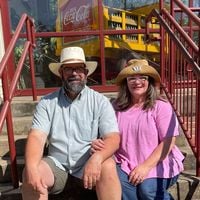Imagine growing plants in your own garden from seeds of plants your ancestors grew almost 200 years ago. Well, that’s exactly what’s taking place all around Louisiana thanks to a new program that has kicked off: the Northeast Louisiana Seed Preservation Program.
Kerry Heafner, a local horticulturist for the LSU Ag Center, spoke at the Marion Garden Club meeting in February 2020 about heirloom apples: apples grown locally from grafted scions of parent trees from generations before. Many people debate over this topic saying apples cannot grow in the Louisiana climate. But that’s a story for another day.
After the meeting, a lady walked up to Kerry and told him that she had something that he might be interested in. She explained that she had some watermelon seeds that she thought might have been developed at the old Calhoun Station. The Calhoun Station of the LSU Ag Center was established in 1888. Throughout its history, there were countless fruits and vegetables grown on-site.
Red and Sweet Watermelon, Kerry Heafner, LSU Ag Center |
Kerry hurried to her home and got some of the seeds that he found stored in her deep freeze in an old cracker tin. There were three paper bags inside: one was from 2001, one was from 2003, and one was from 2006. They all three read “Red & Sweet”. He grew them out in 2020. The results were astounding. One vine put off about 15 fruits with six of them weighing in at over 30 pounds. One was a staggering 46 pounds. Their BRIX scores, the scale used to measure the sweetness of the melon, were through the roof, too. A good score is between 10 and 11. These melons were between 12 and 13. Kerry had found a winner. He preserved the seeds for the future and soon found out that another Calhoun melon was growing nearby, the Calhoun Sweet.
Cracker Tin with Red and Sweet Watermelon Seeds, Kerry Heafner, LSU Ag Center |
The Calhoun Sweet was released in 1951 and adored by people across north Louisiana. It was thought to be lost, having not been seen in years. There was a rumor that an old farmer in Lincoln Parish, using mule and plow, was growing some. When approached about his watermelon crop and its uniqueness, the gentleman simply said he had saved his seeds each season. He had no reason to ever know that the plant was extinct, so to speak. Kerry was given some seeds and grew them out. Now they, too, are part of the program.
THE LOUISIANA KITCHEN GARDEN
The Louisiana Purchase Gardens and Zoo is essentially an experimental garden for many varieties of these heirloom seeds as part of the Northeast Louisiana Seed Preservation Program. Kerry has the “Louisiana Kitchen Garden” growing near the train depot. Plants rotate with the seasons, but on our recent visit, he had some Dutch Case Knife Green Beans growing. They are believed to be one of the oldest varieties of green beans still in circulation having grown at the Rosedown Plantation in the 1800’s. They’ve also grown purple beauty bell peppers, Pitre’s Red Bush Okra, Yellow Creole Corn that was originally used to make grits, a white cucumber believed to have arrived in North Carolina in the 1750’s, some, and one of the most beautiful vegetables I have ever seen: the Montelaro Eggplant. The story goes that the Montelaro family brought these to the Mamou and Eunice communities when they arrived in the United States from Sicily in the 1800’s. Their green skin resembles that of a watermelon, and the flavor is said to be milder than the purple eggplant we see at the grocery store.
Montelaro Eggplant, Kerry Heafner, LSU Ag Center |
Purple Beauty Bell Peppers, Kerry Heafner, LSU Ag Center |
Pitre’s Red Bush Okra, Kerry Heafner, LSU Ag Center |
Huey P. Long Field Peas, Kerry Heafner, LSU Ag Center |
Seed sharing and preservation have become important ways of keeping family traditions alive. In fact, there are heirloom seed collectors all over who track down seeds of different varieties to reintroduce them. Plants that were thought to be gone for generations can be found growing all over now.
FOR THE KIDS:
There is also a wonderful educational program for kids, Seeds to Success, The Louisiana Farm to School Program. This is a great way to introduce your kids to seeds, and gardening, there are even great recipes! Farm to School is a nationwide effort to connect schools with local, fresh food while generating excitement around healthy food choices among children. While every farm-to-school program looks somewhat different, they generally include one of the three core elements of farm-to-school programs: procurement (food purchases and the use of local foods as meals, snacks, and taste tests), education (educational activities related to agriculture, food, health, or nutrition), and school gardens hands-on learning and engagement through gardening). Students learn about local agriculture and have access to delicious local foods; farmers gain new markets for their products; local economies grow stronger.
HOW CAN YOU GET SOME HEIRLOOM SEEDS?
The idea of the Northeast Louisiana Seed Preservation Program is to get these plants back into regular production with home gardeners. Individuals can mail a self-addressed envelope to the LSU Ag Center to get their own seeds to plant, and then let the center know how their crops do. If the seeds are available, they will send them out.
For more information:
Kerry Heafner, Area Horticulturist
704 Cypress Street
West Monroe, LA 71291
kheafner@agcenter.lsu.edu
Don't forget to SUBSCRIBE to our free weekly e-newsletter! You will get all the latest local events, family-friendly educational articles, crafts, recipes, and so much more!


